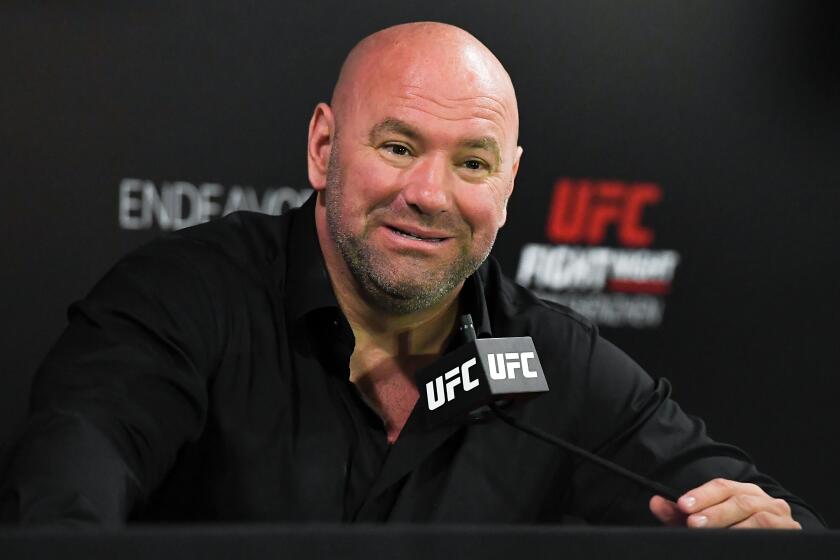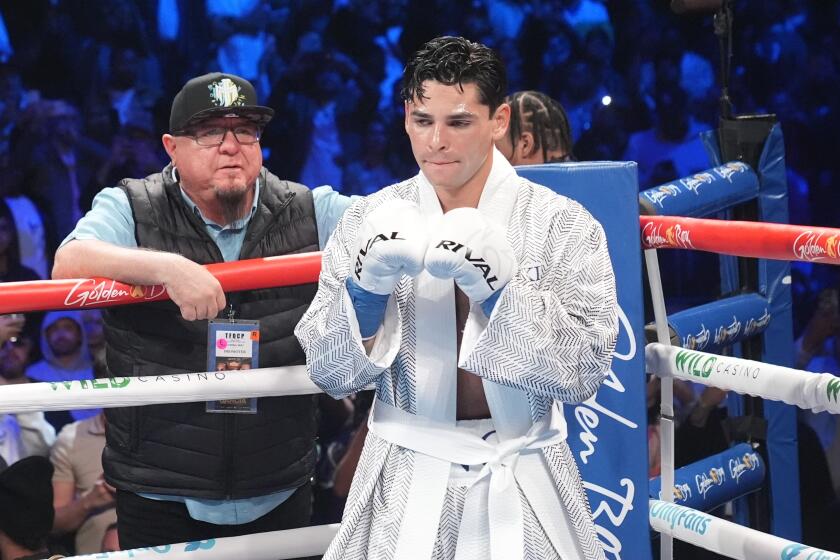It’s About Time for a Change in Main Event
Forget Mike Tyson.
Move on.
Focus on next month’s Evander Holyfield-Lennox Lewis fight. Or on Oscar De La Hoya. Or Shane Mosley, Fernando Vargas, Floyd Mayweather or any of the other talented fighters out there.
For too long, boxing has been held hostage by Tyson. For too long, the focus of this sport has been on bloodied ears and commission hearings and judges’ rulings and mental- health examinations.
When he was young, Tyson was truly a great fighter, a warrior in a heavyweight division filled with overweight, undertrained fighters. By the time Tyson came along in the mid-1980s, boxing fans were hungry for a new hero.
And even when Tyson proved to be the anti-hero, boxing, desperate for its place on the crowded sports page, hung on for what proved to be a bumpy road to oblivion.
Some argued that Tyson was never that imposing, that he had merely been the best of a bad crop of heavyweights. But that’s rewriting history. The Mike Tyson of the 1980s didn’t simply knock out people, he destroyed them. Longtime observers could never remember seeing the look of genuine fear they saw in Tyson opponents.
But all that changed with his first fight against Holyfield in November 1996, his first big fight after three years in prison for a rape conviction. Suddenly, Tyson was exposed as a bully without the weapons to back up the bravado. Holyfield matched Tyson stare for stare, dirty tactic for dirty tactic.
Whether it was the fact that the years of inactivity had robbed his body of its skills, or the years of tumult with promoter Don King and controversial co-managers John Horne and Rory Holloway had drained his mind of the enthusiasm and concentration needed to excel, there was no question that this was a different Tyson. He suddenly looked like all those opponents he had caused to freeze in terror.
Even after he bit off part of one of Holyfield’s ears in their 1997 rematch, the fascination remained. Whether he was testifying in front of the Nevada State Athletic Commission in a bid to regain the license stripped from him after the ear incident, or telling his sad life story to mental-health examiners, Tyson remained the center of attention in the boxing world.
His comeback fight last month against Francois Botha was the first sign that the attention span was near its end. Attendance for the fight at the MGM Grand Garden Arena in Las Vegas was so poor that hotel employees had only to pay the tax on the tickets in order to get a seat, thus filling out the arena and saving face for the promoters. The number of pay-per-view buys was under 700,000, less than half of what Tyson’s name sold in his heyday.
And now he’s back in limbo, a series of obstacles in his path back to yet another comeback. And all the angry stares in the world aren’t going to remove them.
First, of course, is the sentence in Maryland. Unless a planned appeal by his lawyers is successful, Tyson must serve at least six months of his one-year sentence for assaulting two motorists after a traffic accident. A judge in Indiana must decide if Tyson will be given additional jail time in that state if it is determined that he has violated the terms of his parole. Nevada could again strip him of his license, which expires at the end of the year.
Tyson temporarily solved his financial problems following the Botha fight by paying the government the $13 million he owed in back taxes.
But that’s hardly the end of his monetary problems. Thirteen million dollars worth of his $23-million payday from the Botha fight came from future earnings. If he has no future in the ring, is that money free and clear?
Tyson received a $5-million loan from his new promoter, America Presents, to be paid back in two equal amounts after his two fights under the America Presents banner. If there is no second fight, does he still have to pay it back?
And what of the money he earned against Botha? That will be taxed next year. But if Tyson doesn’t fight again, how will he pay that?
So the Tyson saga will continue to be played out in courtrooms and commission hearings and government offices rather than the ring.
And should he somehow return to fight again, another layoff for the 32-year-old fighter will only further erode his skills.
Tyson may yet fool us all, find the resolve to overcome this mountain of problems piling up in front of him, knock off the rust and the decay and become the Tyson he once was.
And Wilt Chamberlain might yet make that comeback he is always talking about.
But don’t plan your calendar around it.
Boxing will survive. It always does.
But to prosper, it must give up its obsession with Tyson, relegate him to history, at least for now, and shift the focus from the judges in the courtroom to the judges in the ring.
More to Read
Go beyond the scoreboard
Get the latest on L.A.'s teams in the daily Sports Report newsletter.
You may occasionally receive promotional content from the Los Angeles Times.










